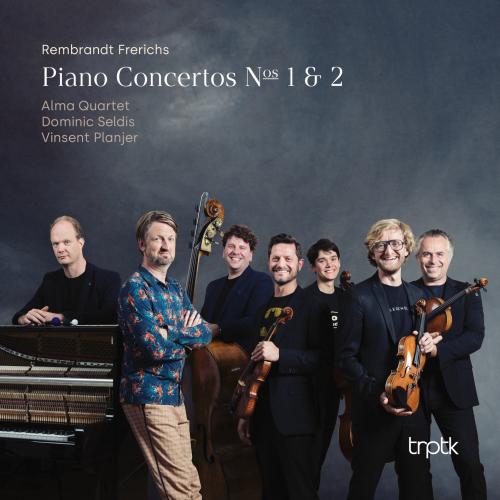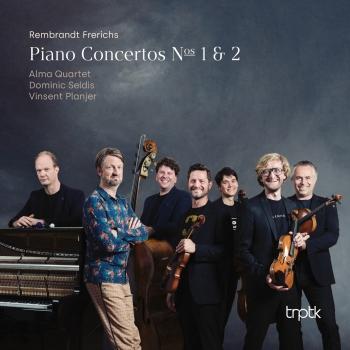
Frerichs: Piano Concertos Nos. 1 & 2 Rembrandt Frerichs, Alma Quartet, Dominic Seldis and Vinsent Planjer
Album Info
Album Veröffentlichung:
2021
HRA-Veröffentlichung:
22.04.2022
Label: TRPTK
Genre: Classical
Subgenre: Concertos
Interpret: Rembrandt Frerichs, Alma Quartet, Dominic Seldis and Vinsent Planjer
Komponist: Rembrandt Frerichs (1977)
Das Album enthält Albumcover Booklet (PDF)
- Rembrandt Frerichs (b. 1977): Piano concerto No. 1:
- 1 Frerichs: Piano concerto No. 1: I. Textures and registers 03:38
- 2 Frerichs: Piano concerto No. 1: II. Cadenza I 02:32
- 3 Frerichs: Piano concerto No. 1: III. Bohemia theme 04:55
- 4 Frerichs: Piano concerto No. 1: IV. Cadenza II 02:47
- 5 Frerichs: Piano concerto No. 1: V. Elasticity 03:52
- 6 Frerichs: Piano concerto No. 1: VI. A wind sweeps us through the world 05:36
- 7 Frerichs: Piano concerto No. 1: VII. Musique au font 09:28
- 8 Frerichs: Piano concerto No. 1: VIII. Blue pencilled outlines 07:13
- Piano concerto No. 2 "Eternal variating alternations":
- 9 Frerichs: Piano concerto No. 2 "Eternal variating alternations": I. 1st Movement 05:47
- 10 Frerichs: Piano concerto No. 2 "Eternal variating alternations": II. 2nd Movement 04:23
- 11 Frerichs: Piano concerto No. 2 "Eternal variating alternations": III. 3rd Movement 06:18
- 12 Frerichs: Piano concerto No. 2 "Eternal variating alternations": IV. 4th Movement 03:25
Info zu Frerichs: Piano Concertos Nos. 1 & 2
For pianist and composer Rembrandt Frerichs (1977), a new musical adventure began when viola player Michael Gieler invited him for an open conversation. Gieler is a solo violist with the Royal Concertgebouw Orchestra and leader of the IJ-Salon series, a cross-border ‘playground’ of chamber music with musicians of the Royal Concertgebouw Orchestra. Gieler planted a seed that grew into a composition commission for Rembrandt’s first Piano Concerto. Rembrandt took up the challenge.
Rembrandt Frerichs already came into the spotlight through composition commissions from leading musicians, including Liza Ferschtman and Amsterdam Sinfonietta. His star is rising further now that musicians of the Royal Concertgebouw Orchestra have asked him to compose a brand new piano concerto that features himself as soloist.
It is a logical consequence of his artistic choices over the past decade that Rembrandt has come to be known as a forward-thinking free spirit for musicians who want to break out of the confines of their professional practice. In his projects, he makes every effort to test both his own limits and those of his fellow musicians. On this album this can be heard, for example, on the track “Finale,” where the strings are plunged into a rhythmic world not yet common to classical musicians.
Rembrandt: “Mahler’s Fourth is well-known territory for these musicians. We have known for a hundred years what it is supposed to sound like. For improvising musicians, everything they make is living material that can constantly change. We afford ourselves more liberties. And we know, the wrong note is where the adventure begins! In the second piano concerto, you can hear a great example of living material in the 3rd movement when the strings hold a long note and they have no idea what I’m going to do with that note.”
It’s easy to forget, but imagine that you could travel in a time machine to a Beethoven or Mozart concert and you would notice that Ludwig and Wolfgang mainly played their own work. Moreover, they often did not have a notated piano score. Later, one of these performances was transcribed and notated for publishing purposes. This score, passed on from generation to generation, has led to the widespread misconception that in what we now call classical music all the notes were always the same.
The approach Rembrandt takes here goes back to the original performance practice of the great masters. It shows that classical and jazz are not as far apart as is often thought.
As in their time, a performance of the piano concerto is an experience of tailor- made music for the individual piano soloist. Because of the improvisations, no two concerts are the same. An illustrative example of this is the 3rd movement of the first piano concerto “Musique au font”, where a joint improvisation begins from 3:20.
Rembrandt: “For a long time it was unclear how the concert would sound in its entirety. The string players didn’t have a picture of the embedding of the piano yet. At the rehearsals I would say something like: I’m going to do something here, but what that is I’ll figure out during the concert. The penny didn’t drop until we played for an audience for the first time at the Oranjewoud festival and the musicians heard the piece in its entirety. You could truly read on their faces, ‘Aaaah so this is what he meant…’ That moment can be heard during the second movement of the piano concerto no. 2.”
As a listener, you experience the musical battle between ensemble and piano; an exhilarating ritual dance of two partners. A new path is taken as improviser Rembrandt combines the best of two worlds with the classical musicians on stage. As with Ravel, Debussy and Gershwin, the composer himself sits at the piano.
Rembrandt: “I want to take the audience into my ‘Black page / white page’ approach, which is to say that the listener is aware that the classical musicians on stage have an actual part with black dots on paper. I, on the other hand, have a completely blank page. I re-imagine the conversation with the orchestra each concert, providing musical commentary and a counterpoint, as on ‘Cadenza 2’ from the first piano concerto. Classical pianists play from a score. With my piano concerto, I take a clear stand in order to shake up performance practice by involving the audience in the creation process. In doing so, I am following the practice of both Mozart and Beethoven, who usually did not write out their piano parts either: they knew the parts of all the other instruments by heart but only created their parts during the concert. My starting point in this is my many years of improvised jazz background, which I bring to the fore in the last movement of the 1st piano concert, ‘Blue Pencilled Outlines’. In how this comes together, that adventure, we take the listener with us during our concerts.”
Rembrandt Frerichs, piano
Marc Daniel van Biemen, 1st violin
Benjamin Peled, nd violin
Jeroen Woudstra, viola
Clément Peigné, cello
Dominic Seldis, double bass
Vinsent Planjer, percussion
Rembrandt Frerichs
(1977) ist ein Pianist mit einer breiten Perspektive. Er konzentriert seine Energie auf Ideen, die für ihn von Bedeutung sind und seine künstlerische Reise vertieft sich ständig in neue Gebiete. Durch seine Zusammenarbeit mit Michael Brecker im Alter von nur 25 Jahren und einem Doppelkonzert mit Chick Corea in London ist Rembrandt mit der amerikanischen Jazztradition vertraut, doch will er ausgetretene Pfade vermeiden. Rembrandts Kenntnis der Musik verschiedener Teile der Welt drängt seine Kompositionen zu einer kontinuierlichen Weiterentwicklung, wobei er die Grenzen der klassischen, improvisierten und Weltmusik verschiebt.
Im Alter von 22 Jahren gab Rembrandt sein Debüt beim North Sea Jazz Festival. Während dieser Zeit erhielt er das Stipendium für hervorragende junge Musiker, um in New York City zu studieren. Unmittelbar nach seinem Abschluss wurde er gebeten, an verschiedenen Musikuniversitäten zu unterrichten. Gegenwärtig ist Rembrandt Professor am Konservatorium in Utrecht.
Sein 2006 veröffentlichtes Debütalbum wurde für den niederländischen Grammy (Edison Award) nominiert. Rembrandts Musik führte ihn in einige der legendären Jazzclubs der Welt, wie das Birdland in New York, Ronnie Scotts in London und Festivals und Clubs in Europa, Amerika und dem Fernen Osten. Im Jahr 2017 war sein Rembrandt Frerichs Trio der Eröffnungsakt beim Jazzfestival Taiwan, wo er vor 50.000 Menschen auftrat.
Der Sommer 2013 markierte den Beginn einer neuen künstlerischen Reise: das Contemporary Forte Piano.
Rembrandts tiefes Interesse an der Erkundung verschiedener Arten des Klavierspiels wird durch seine ständige Recherche unterstützt. Sein Interesse für den Klang alter Musik und orientalischer Instrumente wie Santur und Qanun brachte ihn zum Hammerflügel. Rembrandt bringt nun Elemente der Musik des Barock und des Nahen Ostens in seine improvisierten Sets ein und arbeitet dabei mit den Meistern der persischen Musik Kayhan Kalhor und Hossein Alizadeh zusammen. Der niederländische Nationale Instrumentenfonds ist von dieser neuen Richtung so begeistert, dass er eigens für Rembrandt ein Hammerklavier bauen ließ.
Als Komponist wurden seine Kompositionen sowohl von klassischen als auch von Welt- und Jazzmusikern aufgeführt und aufgenommen. Unter ihnen: die Geiger Liza Ferschtman, Hugo Ticciati (UK), Antoinette Lohmann, Niek Baar und Rosanne Philippens, Holland Baroque, Nederlands Kamer Orkest, Cello 8tet, Remy van Kesteren, Mahan Esfahani (UK), das Osiris Trio, das Storioni Trio, Ties Mellema, Frode Halti (NOR), Izhar Elias, Levan Tskhadadze (GRG), Dominic Seldis (UK), Rick Stotijn, Amstel Quartett, Matangi Quartett, Zapp Streichquartett, Hermine Deurloo, Klaartje van Veldhoven, Kayhan Kalhor (Iran), Hossein Alizadeh, Mahsa Vahdat, Paolo Fresu (IT), Trygve Seim (NOR), Norma Winstone (UK), Perico Sambeat (ESP) und Jim Black (US).
Seine Musik wurde auch für Theaterstücke in Japan und von der Tanzkompanie Bielefeld (Deutschland) verwendet.
2004 wurde er zu einer Tournee des European Jazz Youth Orchestra durch Brasilien und Europa eingeladen, bei der er mit Hermeto Pascoal arbeitete.
Booklet für Frerichs: Piano Concertos Nos. 1 & 2









